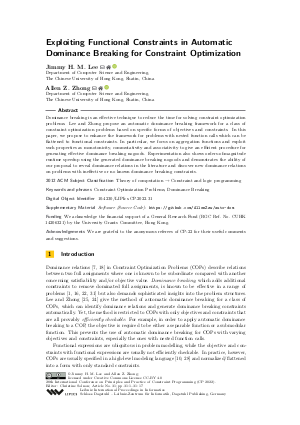LIPIcs.CP.2022.31.pdf
- Filesize: 0.79 MB
- 17 pages

 Creative Commons Attribution 4.0 International license
Creative Commons Attribution 4.0 International license

Dominance breaking is an effective technique to reduce the time for solving constraint optimization problems. Lee and Zhong propose an automatic dominance breaking framework for a class of constraint optimization problems based on specific forms of objectives and constraints. In this paper, we propose to enhance the framework for problems with nested function calls which can be flattened to functional constraints. In particular, we focus on aggregation functions and exploit such properties as monotonicity, commutativity and associativity to give an efficient procedure for generating effective dominance breaking nogoods. Experimentation also shows orders-of-magnitude runtime speedup using the generated dominance breaking nogoods and demonstrates the ability of our proposal to reveal dominance relations in the literature and discover new dominance relations on problems with ineffective or no known dominance breaking constraints.





































Feedback for Dagstuhl Publishing